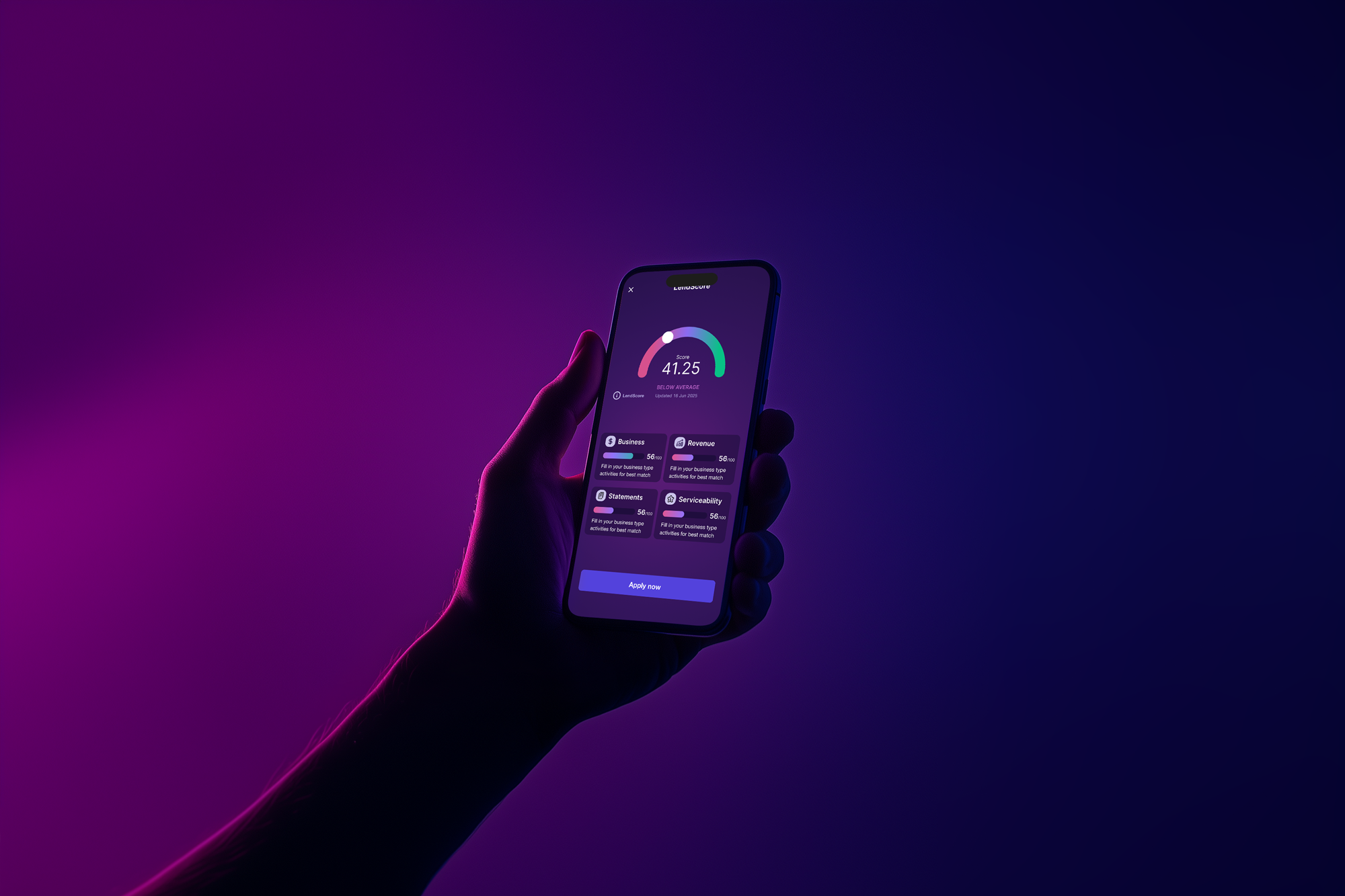Best Business Overdraft Rates 2025 - Get Up To $2m
Our LendIQ™ system finds your ideal business overdraft up to $2 million, helping you compare some of the best rates available

Secure Your Overdraft in 3 Easy Steps
Provide Your Info
Fill out a quick questionnaire so we can understand your unique situation. This is 100% free and won't affect your credit score.
Find Your Match
Our LendIQ™ system reviews 80+ providers for you and gets you the best deal with the highest first application approval chance.

Get Funded Fast
If the product suits you, confirm by phone to get approved and funded, with same-day funding possible.
Why Compare Business Loans with Lend?
Our smart technology and expert team save you time, protect your credit score, and find you a great deal on business finance.
Trusted by Aussies
With over 50,000 loans funded and an 'Excellent' 4.8/5 rating on Reviews.io, we are one of Australia's most trusted platforms for securing business finance.
Free to use
Our comparison service is 100% free. Our mission is to help Aussie businesses find their lowest interest rates.
Safe & secure
Our process does not affect your credit score at all. It's safe to compare with us.
Why Comparing Business Overdrafts Is Smart
Comparing your options gives you certainty. It ensures you get the right capital quickly, every time your business needs it.
Our team achieves over 80% approval rate for both new and established businesses.
50,000+
Loans Funded
4.8/5 ⭐️
Excellent on reviews.io
"Traditional overdraft processes are often slow and uncertain, causing missed opportunities. At Lend, our LendIQ™ system changes this. We match businesses to the best overdraft from 80+ providers, meaning you secure capital in days, not weeks, and confidently manage your cash flow."
— Andrew Beckett, Head of Broker & Third Party Distribution
Speak to an Overdraft Expert
Find Your Best Overdraft Rate Now
Get a competitive rate from over 80 lenders. Enter your desired overdraft amount to see your options in minutes.
Our promise: no credit score impact
A Complete Guide to Business Overdrafts in Australia
This guide explains how a business overdraft works, what it costs, and how to find the best option for your needs.
Updated: 11/10/2025
Business Overdrafts by the Numbers
A business overdraft is a vital tool for managing day-to-day cash flow. Our internal data shows it's a cornerstone of operational stability for Australian SMEs, particularly in service-based industries.
Share of all working capital requests
Average overdraft facility approved
Top industries for requests

What Is a Business Overdraft?
A business overdraft gives you flexible access to funds up to an agreed limit, designed to manage inconsistent cash flow. Think of it as an "always on" financial buffer. You only pay interest on the amount you use, not the entire limit. This puts you in control, making it ideal for covering unexpected expenses or seizing opportunities without paying for funds you don't need.
Secured vs. Unsecured Business Overdrafts

- Unsecured Business Overdrafts: Get funds quickly without using your assets as security. The application process is faster, offering maximum financial flexibility. This is a common choice for small businesses needing quick access to capital. 90% of our clients choose an Unsecured Overdraft.
- Secured Business Overdrafts: Access lower interest rates and potentially higher limits by using assets like commercial property or vehicles as security. If you need a larger facility and prefer reduced costs, a secured overdraft is a significant advantage. 10% of our clients choose a Secured Overdraft.
Business Overdraft Eligibility Checklist
Knowing what providers look for can help you apply with confidence. Here’s a checklist of the usual requirements:
- Active ABN/ACN: Your business must be registered in Australia.
- Trading History: You generally need to be in business for at least 6.
- Minimum Revenue: Most institutions look for a consistent turnover of at least $75,000 per year.
- Australian Resident Director: At least one director must be an Australian citizen or permanent resident.
- Credit History: A good financial score helps, especially for an unsecured overdraft, but options may exist for different profiles.
Essentially, your business generally needs an Australian ABN/ACN, to be operating for at least 6, and meet a minimum turnover requirement. The funds must be for business use. Our LendIQ™ system checks your business details against 80+ providers. This means we can often find options even if you have been rejected elsewhere, expanding your access to vital capital.
How a Business Overdraft Works

A business overdraft provides a revolving line of credit that acts as a flexible funding source you can draw from, repay, and draw from again as your cash flow changes. This provides a critical financial buffer for any working capital need, from covering unexpected costs to paying suppliers while waiting on invoices.
- Borrow from $5,000 to over $2,000,000
- Loan terms from 3 months to 5 years
- Weekly, fortnightly or monthly repayments
- Interest only on funds you use
- Secured and unsecured options available
- Business loan interest and fees may be tax-deductible
What Impacts Your Financing Costs?
The rates offered by a provider reflect their assessment of your business. Several key factors influence the final variable interest rates, which typically range from around 9.95% to 30% p.a
Security Provided
A secured overdraft, backed by assets like property, represents lower risk to providers and attracts more competitive rates. The average approved limit for an asset-backed overdraft is $130,000.
Business Trading History
A longer track record of consistent revenue demonstrates stability and may lead to more favourable loan terms. Most lenders prefer a business to be operating for at least 12 months.
Credit History
Providers assess the financial reports of both the business and its directors. A strong history is crucial for securing the best rates.
Industry and Revenue
Businesses in stable industries with consistent, verifiable turnover are often viewed more favourably.
Your Business Overdraft Questions

You can use a business overdraft for almost any legitimate purpose, including managing cash flow, buying stock, covering working capital gaps, and paying contractors or suppliers.
It depends on your needs. An overdraft is ideal for ongoing, fluctuating cash flow requirements. A term loan is generally better for large, one off purchases like equipment, as it typically offers a lower financing cost.
Making initial enquiries or using comparison services generally does not impact your credit score, as these are 'soft' checks. A 'hard' check is only performed when you submit a formal application to a specific provider.
The terms are often used interchangeably. Historically, an overdraft was linked to a business banking transaction account, while a business line of credit was a standalone product. Today, they function in much the same way.
While possible, it's often not the most cost effective option. An overdraft is perfect for short term needs. A dedicated equipment loan will almost always offer a lower cost for a large, long term asset.
Helpful Finance Tools
Costs, Fees & Repayments
Understanding The Costs: Business overdraft interest rates typically range from 9.95% to 30% p.a., varying by the institution and whether security is provided. Overdraft interest is calculated daily only on the funds you have drawn. Our experts help you navigate these costs to find your best deal, ensuring you understand all associated pricing and any potential overdraft fees.
Common Fees to Expect:

- Establishment Fee: A one time charge when the overdraft is set up (typically 0.75% to 4% of the limit).
- Line Fee: An ongoing fee for maintaining the unused portion of your facility (around 1% p.a.).
- Service Fee: A flat monthly fee that may apply.
- Annual Review Fee: Charged if your limit is reviewed yearly.
- Discharge Fee: Applies if you choose to close the account.
- Outcome: Lend's specialists ensure full transparency on all fees upfront, so you avoid hidden costs and understand the true cost of your facility.
Flexible Repayment Terms: Overdraft terms usually range from 3 months to 5 years, with open ended arrangements also possible. Repayments are typically weekly or monthly for businesses with a turnover under $5 million, offering flexibility that aligns with your business cash flow cycles. We help you find terms that work for your business model.
Overdraft Benefits & Considerations to Make the Right Choice
Pros
• Cost Efficient
You only pay interest on the exact amount of funds you use.
• Ultimate Flexibility
Use funds for any business expense, including inventory, salaries, marketing campaigns, or unexpected emergencies.
• Seamless Access
Can be linked directly to your business account or set up as a convenient standalone facility.
• Easy to Close
Cancel your facility anytime once the outstanding balance is repaid.
Cons
• Higher Cost Than Term Loans
These options generally have higher interest rates and fees compared to traditional business loans because of their flexibility.
• Not for Long Term Purchases
An overdraft is best for short-term cash flow management, not major asset purchases.
• Fees Can Accumulate
Be aware of potential account-keeping and usage fees. We help clarify these to prevent surprises.
• Lender Can Cancel Facility
Providers can cancel your overdraft if the terms of the agreement are breached. We help ensure you fully understand your commitments.
Your Top Questions, Answered
You can typically access between $5,000 and $2 million. Your specific overdraft limit is based on your business's revenue and financial history. The median funded overdraft through Lend is $90,000.
Historically, lines of credit were standalone products, while overdrafts were linked to bank accounts. Today, the terms are often used interchangeably, with many non-bank providers offering standalone overdrafts that function like a line of credit.
An overdraft is ideal for covering larger cash flow gaps and short term expenses, often providing bigger limits. Business credit cards are better for everyday operational spending and earning rewards, but usually have higher interest rates.
Yes, it is possible. Non-bank financial institutions available through Lend are often more flexible than traditional banks. While your initial borrowing capacity might be lower or the interest rate higher, our system finds the providers most likely to approve your application, giving you viable options. In fact, 60% of our approved overdrafts go to clients who have a managed ATO debt.
How to Apply for Your Overdraft
1
Prepare Your Information
Gather necessary documents upfront. This typically includes your ABN/ACN, business and personal bank statements for the last 6 to 12 months, and ID for all directors.
2
Compare Lenders and Products
Research different providers, including major banks and non bank specialists. Review their financing costs, fees, and criteria to create a shortlist of suitable options.
3
Speak With a Specialist
Once you have chosen a provider, you will typically speak with a loan specialist. They will discuss your options, answer questions, and clarify the terms and final documents required.
4
Formal Application and Activation
After submitting a formal application, the provider will conduct its final assessment. Upon approval and signing the documents, your overdraft is activated, often within 24 to 72 hours for small business, low-doc lending.
Final Questions on Small Business Overdrafts

Yes, it's possible. While some providers prefer a longer trading history, many non-bank lenders specialise in finance for newer businesses. If your small business (trading 6 months to 2 years) is trading positively, you have a good chance of approval.
Repayments are based on the amount you have used. As a guide, for a $50,000 unsecured overdraft, weekly repayments might be around $350. This can vary based on your interest rate and loan term.
A director's guarantee is a standard requirement for most unsecured business finance in Australia. It is a personal commitment from the director(s) to repay the debt if the business cannot.
Yes. As your business revenue grows, you can apply to increase your limit. Lenders will typically want to see 3 to 6 months of sustained, positive performance before approving a higher facility. These increased overdraft limits can be beneficial.
For funding amounts over $250,000, lenders need a deeper understanding of your business's financial health. Providing full financials is key to unlocking these larger facilities.
Yes, specialists can guide you through a provider's process for securing pre-approval. This gives you a confirmed facility limit before you need it, providing financial peace of mind.
Our goal is to build long term partnerships. 70% of our approved overdraft clients return to us for a second financial product within 18 months. We aim to be a trusted funding partner throughout your business journey.
Non-bank lenders often have more flexible credit policies and can approve applications faster than traditional banking institutions. They may be more willing to consider applications with managed tax debt or past credit issues.
What Happens After Your Overdraft Has Been Approved
Once you have signed the documents, a settlement team works with the provider to establish the facility. You will be notified the moment your overdraft is active. Your finance specialist will also explain the simple process for drawing down funds so you can access your capital immediately.mains available to you, ensuring a smooth conclusion to your funding journey.
Andrew Beckett is a finance executive with extensive Fintech expertise. As Head of Broker and Third Party Distribution at Lend, he fostered key partnerships, including COG aggregation and CAFBA. With prior sales roles in various fintech and finance companies, Andrew has been instrumental in transforming Australia's financial market, shaping new lending practices in the commercial lending space.
Andrew Beckett, Head of Broker and Third Party Distribution
Phil Druce leads the company’s technology and operations. With 20 years of experience in technology businesses, Phil has consistently driven growth through strategic planning and execution. Since 2016, he has been dedicated to creating technology-driven products and services at Lend, optimising processes, and delivering outstanding client experiences.
Phil Druce, Chief Operations Officer
Stories From Successful Business Overdraft Facilities
Securing Stability: A Flexible Overdraft for a Hospitality Business

Client: Jean, a bar owner.
Problem: Jean faced the classic hospitality challenge: managing seasonal cash flow peaks and troughs. She needed a flexible facility to cover essential working capital like stock and wages during slower periods, ensuring business continuity.
Solution: We secured Jean a $125,000 overdraft facility structured over a three-year term. This gives her a crucial financial buffer, empowering her to manage operational costs with confidence and strategically invest in the business, knowing she has the capital ready when she needs it most. It provides stability in a notoriously volatile industry.
Civil Contractor Funded With $150k

Client: Stephen, Civil Construction Contractor
Problem: Civil contractor Stephen required a $150,000 overdraft to fund expansion and new projects. His bank promptly rejected the application due to an active ATO payment plan, stalling his growth.
Solution: Recognising the business's strong fundamentals, we secured the full $150,000 facility from a specialist lender within 24 hours. Stephen accessed the capital needed to proceed immediately, without altering his existing financial commitments, proving that a bank's "no" isn't the final answer.
Existing Debts Consolidation Funded With $200k

Client: Dean, Fire Systems Service Provider
Problem: Dean’s fire systems business needed to consolidate existing debts and access an extra $200,000 to manage growth and ongoing contract costs.
Solution: We secured a single, flexible $500,000 overdraft facility to achieve both goals. Structured over a three-year term, this allows Dean to draw down and repay funds in line with his project-based income cycles. This provides the strategic cash flow control required to scale operations and take on larger contracts with confidence.
Get Competitive Business Overdraft Rates in Minutes
Enter your desired amount below to instantly compare 80+ providers and secure the best overdraft for your business. We help you find a competitive business overdraft.
Our promise: no credit score impact

